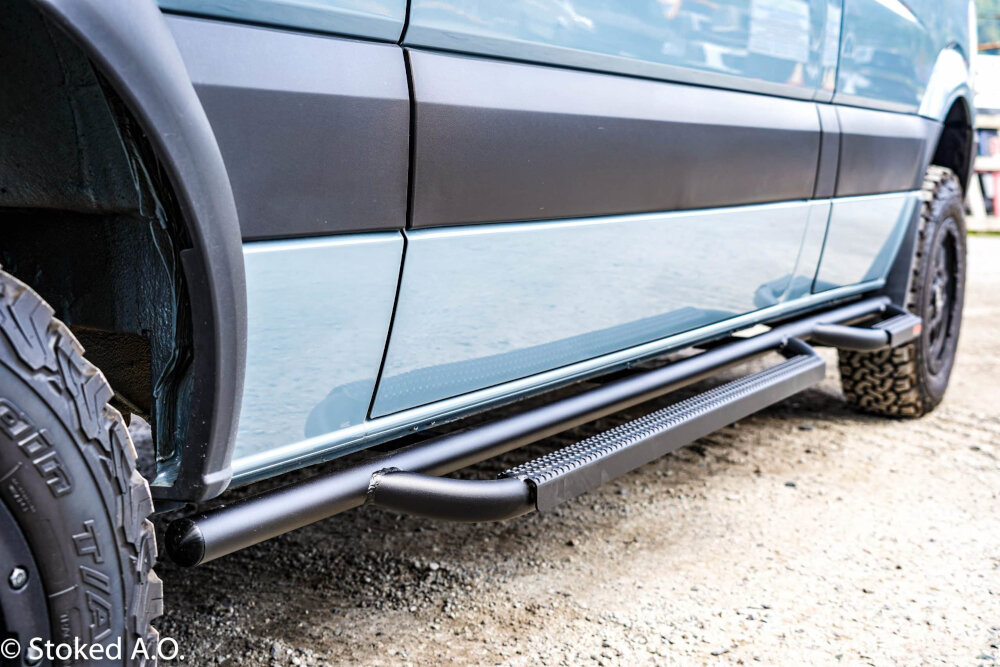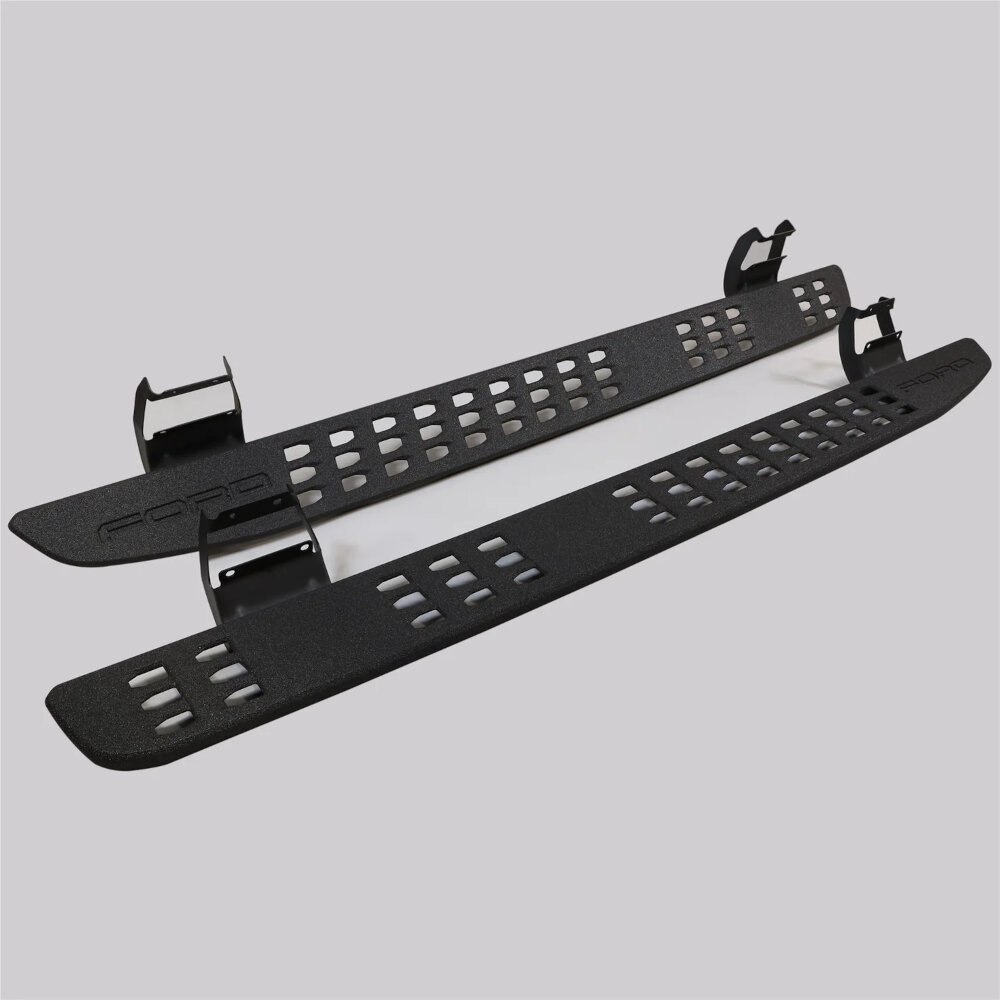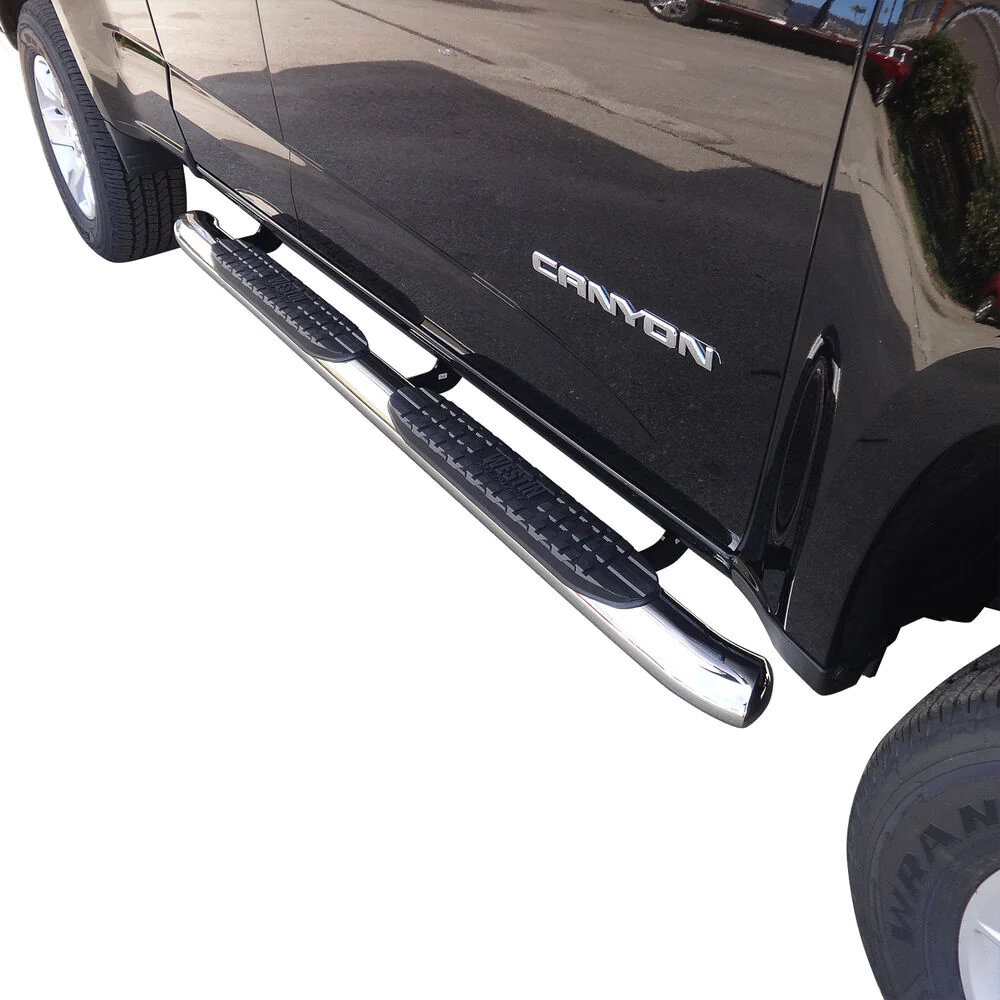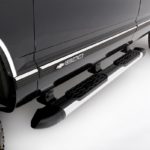Factory vs Aftermarket Running Boards: Understanding the Key Differences

When it comes to upgrading your vehicle with running boards, you may find yourself faced with the decision of choosing between factory or aftermarket options. While both options serve the same purpose of providing a step for easier entry and exit from your vehicle, there are some key differences between them that you should be aware of before making your decision. Understanding these differences can help you make an informed choice that best suits your needs and preferences. Factory running boards are those that are installed by the vehicle manufacturer at the time of production. These running boards are designed to fit seamlessly with your vehicle’s existing look and feel, and are often made from high-quality materials that are built to last. On the other hand, aftermarket running boards are produced by third-party manufacturers and are designed to be compatible with a wide range of vehicles. While they may not always match your vehicle’s aesthetics perfectly, they can often offer more customization options and may be more affordable than factory options.
Running boards are an accessory that is attached to the side of a vehicle, typically just below the doors, to make it easier for passengers to enter and exit the vehicle. They are typically made from materials such as aluminum or steel and come in a variety of shapes and sizes to fit different vehicles. Running boards offer several benefits, including providing a non-slip surface for passengers to step on, protecting the vehicle’s body from debris and mud, and enhancing the vehicle’s appearance. They are commonly used on trucks and SUVs, where the distance from the ground to the door is higher, making it more difficult for passengers to get in and out of the vehicle. Overall, running boards are a practical and stylish accessory that can make a significant difference in the accessibility and appearance of a vehicle.
Factory running boards are originally installed by the vehicle manufacturer and are designed to perfectly fit the make and model of the vehicle. These running boards are made with high-quality materials and are designed to meet the specific standards and specifications of the vehicle manufacturer. In contrast, aftermarket running boards are produced by third-party manufacturers and are not designed specifically for a particular vehicle make and model. These running boards are often made with lower quality materials and may not fit as well as factory running boards. While aftermarket running boards may be more affordable, they may not provide the same level of durability, functionality, or aesthetic appeal as factory running boards. Ultimately, the choice between factory and aftermarket running boards will depend on the individual’s preferences and needs.
Factory Running Boards

Factory running boards, also known as original equipment manufacturer (OEM) running boards, are running boards that are designed and installed by the vehicle manufacturer. These running boards are specifically designed to fit the make and model of the vehicle, ensuring a perfect fit. Factory running boards are made using high-quality materials and are built to meet the highest standards of safety and durability. They are often made using the same materials as the rest of the vehicle, ensuring a seamless look and feel. The installation of factory running boards is usually done during the manufacturing process, which means they are integrated into the vehicle’s design and structure. This makes them a great option for anyone who wants to maintain the original look and feel of their vehicle. One of the biggest advantages of factory running boards is that they are covered under the manufacturer’s warranty. This means that if there are any issues with the running boards, the vehicle manufacturer will cover the cost of repairs or replacement. Additionally, factory running boards are designed to enhance the vehicle’s overall safety by providing a secure and stable step for passengers to enter and exit the vehicle. They can also improve the vehicle’s appearance by adding a sleek and stylish look. Overall, factory running boards are a great option for anyone who wants a high-quality running board that is designed to fit their vehicle perfectly and is covered under the manufacturer’s warranty.
Factory running boards refer to the original equipment manufacturer (OEM) running boards that are installed on a vehicle during its production. They are designed to match the vehicle’s make and model and are made with the same quality and materials as the rest of the vehicle. Factory running boards are engineered to provide a seamless integration with the vehicle’s body, offering a sleek and stylish appearance. They are also designed to provide a functional step-up for passengers to enter and exit the vehicle with ease. Factory running boards are a popular option for those who want to maintain the original look and feel of their vehicle, while also adding a practical feature. However, they can be more expensive than aftermarket options and may not offer as much variety in terms of style and design.
Factory running boards offer a number of benefits to vehicle owners. They are designed to perfectly fit the make and model of the vehicle, ensuring a seamless integration that enhances the overall appearance. Additionally, factory running boards are built to withstand the rigors of daily use, and they are engineered to provide a safe and secure step up into the vehicle. However, there are also some drawbacks to factory running boards. They can be expensive to purchase and install, and they may not offer as much customization as aftermarket options. Furthermore, some factory running boards may not be as durable as their aftermarket counterparts, and they may not offer as much protection against debris and other hazards on the road.
When it comes to vehicles that come with factory running boards, there are a variety of options available. Many pickup trucks and SUVs from manufacturers such as Ford, Chevrolet, GMC, Toyota, and Nissan come with factory-installed running boards as standard or optional equipment. For example, the Ford F-150, Chevrolet Silverado, and Toyota Tacoma all offer factory running boards as an option. Luxury SUVs such as the Cadillac Escalade and Lincoln Navigator also commonly come with factory running boards. These factory running boards are designed to seamlessly integrate with the vehicle’s body, providing a sleek and cohesive look.
Aftermarket Running Boards

Aftermarket running boards have become increasingly popular in recent years, as they offer a range of benefits over factory-installed options. One of the key advantages is the ability to customize the appearance of your vehicle. Aftermarket running boards come in a wide range of materials, finishes, and styles, making it easy to find a set that perfectly matches your vehicle’s look and feel. Whether you’re looking for sleek and modern or rugged and utilitarian, there is an aftermarket running board option that will suit your needs. Another benefit of aftermarket running boards is the potential for improved functionality. Many aftermarket options are designed with performance in mind, offering features like slip-resistant treads, enhanced grip, and added durability. Whether you’re looking to improve your vehicle’s off-road capabilities or simply want to make it easier to get in and out of, aftermarket running boards can be a great investment. Plus, many aftermarket options are designed to be easy to install, so you can enjoy the benefits of your new running boards without having to spend a lot of time and money on installation. Overall, if you’re looking for a way to customize your vehicle and improve its performance, aftermarket running boards are a great option to consider.
Aftermarket running boards are a type of vehicle accessory that can be attached to the side of a car or truck. These running boards are not installed by the manufacturer but rather added on later by a third-party vendor. They are designed to make it easier to get in and out of the vehicle, especially for people with mobility issues. Aftermarket running boards come in various styles and materials, such as aluminum, stainless steel, or molded plastic. They can also be customized to match the color and design of the vehicle and provide a more personalized look. However, it’s important to note that not all aftermarket running boards are created equal, and it’s crucial to select a reputable brand and ensure proper installation for safety and durability.
Aftermarket running boards offer a cost-effective solution for those who want to add extra foot support and style to their vehicle. These running boards are available in various designs and materials that cater to different needs and preferences. The installation process is also relatively easy and can be done without professional help. However, one downside of aftermarket running boards is their durability. They are often made with cheaper materials that wear out faster than factory-made options. Additionally, they may not match the exact fit and finish of the vehicle, which can affect the resale value. Ultimately, the choice between factory and aftermarket running boards comes down to personal preference, budget, and intended usage.
Aftermarket running boards offer a wide range of options for those who want to customize their vehicles. Some of the most popular brands in the market include Westin, Lund, Aries, and Go Rhino. Westin offers running boards with a sleek and modern look, perfect for those who want to add a touch of style to their trucks. Lund running boards are known for their durability and resistance to corrosion, making them ideal for off-road adventures. Aries running boards, on the other hand, are designed with practicality in mind, featuring slip-resistant treads and a rugged construction. Finally, Go Rhino offers running boards that combine both style and functionality, with options that include LED lights and customizable lengths.
Factors to Consider When Choosing Running Boards

When choosing running boards for your vehicle, there are several factors to consider to ensure that you make the right choice. First, you need to think about the type of vehicle you have, as well as its height and weight. This is because different running boards are designed for different vehicles, and you need to ensure that the running boards you choose can handle the weight of your vehicle without breaking. Additionally, you should consider the size of the running boards, as they need to be wide enough to accommodate the size of your feet and provide adequate support and stability when getting in and out of your vehicle. Another factor to consider when choosing running boards is the style and design of the boards. There are various styles of running boards available on the market, including factory and aftermarket running boards. Factory running boards are designed by the manufacturer of your vehicle, while aftermarket running boards are designed by third-party manufacturers. The style and design of the running boards you choose should complement the look and feel of your vehicle, and match your personal preferences. Additionally, you should consider the durability and quality of the running boards, as you want to ensure that they will last for a long time and provide reliable support when you need it.
Vehicle compatibility is an essential consideration when it comes to choosing the right running boards for your vehicle. Not all running boards are designed to fit every make and model of vehicle. Factory running boards, for instance, are custom-designed to fit specific models and trim levels of a particular brand. Aftermarket running boards, on the other hand, may come in a universal fit or may be designed to fit a specific range of vehicles. It’s crucial to ensure that the running boards you’re considering are compatible with your vehicle to ensure a proper fit and optimal performance. Before making a purchase, be sure to check the manufacturer’s compatibility chart or consult with an expert to avoid any potential issues with installation or safety.
When it comes to choosing running boards for your vehicle, style and design preferences can play a significant role in the decision-making process. Factory running boards are often designed to match the look and feel of the vehicle, providing a seamless integration that enhances its overall appearance. On the other hand, aftermarket running boards offer a wider range of design options, allowing you to customize the look of your vehicle to your liking. From sleek and modern to rugged and utilitarian, there are running board styles to suit any taste. Ultimately, the choice between factory and aftermarket running boards will depend on your individual preferences and priorities, whether that’s aesthetics, functionality, or a combination of both.
When it comes to running boards, the material and durability play a crucial role in determining the quality and longevity of the product. Factory running boards are typically made from high-quality materials such as aluminum or stainless steel, which offer excellent resistance to rust and corrosion. These materials also tend to be lightweight, making them easy to install and remove as needed. On the other hand, aftermarket running boards may be made from lower-quality materials such as plastic or fiberglass, which can crack or break over time. Additionally, aftermarket running boards may not be as sturdy as their factory counterparts, which could lead to safety concerns for passengers getting in and out of the vehicle. Ultimately, the choice between factory and aftermarket running boards will depend on the specific needs and preferences of the vehicle owner.
When it comes to choosing between factory and aftermarket running boards, price and budget are undoubtedly important considerations. Factory running boards are generally more expensive than aftermarket ones due to their brand name and the fact that they are often made with higher-quality materials. However, aftermarket running boards can often be a more cost-effective option for those on a budget, as they are typically less expensive and offer a wider variety of styles and designs to choose from. Ultimately, the decision between factory and aftermarket running boards will depend on your individual needs and preferences, as well as your budget, so it’s important to carefully consider all of your options before making a final decision.
When it comes to running boards, there are two main options available: factory and aftermarket. Factory running boards are designed and produced by the vehicle manufacturer and are typically installed during the production process. They are often made to match the style and color of the vehicle and are designed to seamlessly integrate with the vehicle’s body. On the other hand, aftermarket running boards are produced by third-party manufacturers and are designed to fit a wide range of vehicles. They come in a variety of styles, colors, and materials, and can often be customized to meet the specific needs and preferences of the vehicle owner. While both types of running boards provide the same basic function, there are some key differences to consider when choosing between them.
When deciding between factory and aftermarket running boards for your vehicle, there are several factors to consider. First and foremost, you need to evaluate the quality and durability of each option. While factory running boards are made specifically for your vehicle and are often considered the more reliable option, aftermarket running boards may offer more customization options and can be more cost-effective. Additionally, you should consider the ease of installation, as well as the aesthetics and overall style of each option. Ultimately, the decision comes down to your personal preferences and needs as a vehicle owner.
If you are looking to purchase running boards for your vehicle, it is important to consider the differences between factory and aftermarket options. First, determine your needs and preferences in terms of style, material, and functionality. Do your research and read reviews from other customers to ensure you are getting a quality product that fits your vehicle properly. Consider the warranty and return policy, as well as the reputation of the manufacturer. Ultimately, the decision between factory and aftermarket running boards depends on your individual needs and budget. However, it is important to weigh the benefits and drawbacks of both options before making a final decision.
Conclusion

In conclusion, the debate between factory and aftermarket running boards boils down to personal preference and individual needs. While factory running boards may offer a more seamless and tailored look, aftermarket running boards provide a wider range of options and often come at a lower cost. It’s important to consider factors such as durability, ease of installation, and compatibility with your vehicle before making a decision. Ultimately, both options serve the purpose of providing a convenient stepping surface for entering and exiting your vehicle, and the choice between the two ultimately comes down to what works best for you.


